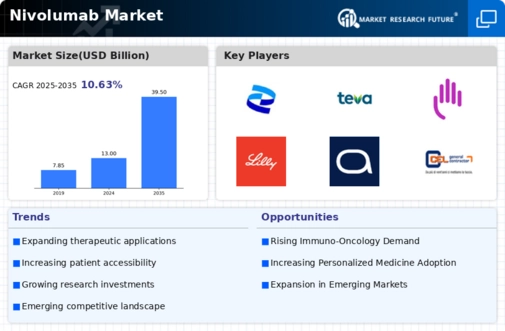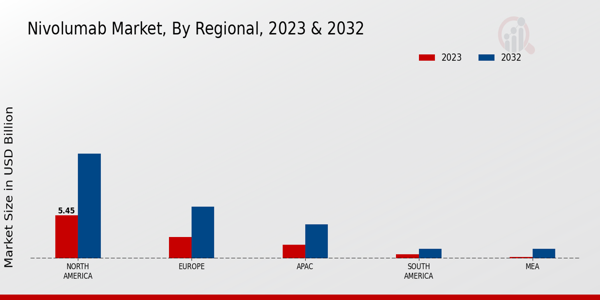Rising Incidence of Cancer
The Global Nivolumab Market Industry experiences growth driven by the increasing incidence of various cancers, particularly lung cancer and melanoma. As cancer rates rise globally, the demand for effective immunotherapies like Nivolumab escalates. In 2024, the market is projected to reach 13.0 USD Billion, reflecting the urgent need for innovative treatment options. The World Health Organization indicates that cancer is a leading cause of death worldwide, which further emphasizes the necessity for advanced therapies. This trend suggests that the Global Nivolumab Market Industry will continue to expand as healthcare systems prioritize cancer treatment.
Advancements in Immunotherapy
Technological advancements in immunotherapy significantly influence the Global Nivolumab Market Industry. Innovations in drug formulation and delivery methods enhance the efficacy and safety profiles of Nivolumab, making it a preferred choice among oncologists. The ongoing research and development efforts are likely to yield new combinations and treatment protocols, thereby expanding the drug's applications. As the market evolves, the Global Nivolumab Market Industry is expected to grow at a CAGR of 10.63% from 2025 to 2035, reaching an estimated 39.5 USD Billion by 2035. This growth is indicative of the increasing reliance on immunotherapeutic strategies in cancer management.
Growing Awareness and Education
Increasing awareness and education regarding cancer treatment options contribute to the growth of the Global Nivolumab Market Industry. Healthcare providers and patients are becoming more informed about the benefits of immunotherapy, leading to higher adoption rates of Nivolumab. Educational initiatives, including seminars and workshops, play a crucial role in disseminating information about the drug's efficacy and safety. This heightened awareness is likely to drive demand, as patients seek out advanced treatment options. Consequently, the Global Nivolumab Market Industry is expected to see a surge in utilization, aligning with the broader trend of informed patient decision-making in healthcare.
Regulatory Approvals and Guidelines
The Global Nivolumab Market Industry benefits from favorable regulatory approvals and updated clinical guidelines that endorse the use of Nivolumab in various cancer types. Regulatory bodies, such as the FDA and EMA, have expedited the approval process for Nivolumab, recognizing its potential to improve patient outcomes. These approvals not only enhance market access but also instill confidence among healthcare providers and patients. As a result, the Global Nivolumab Market Industry is poised for growth, with an increasing number of treatment indications being recognized, thereby expanding the patient population eligible for Nivolumab therapy.
Market Trends and Growth Projections
The Global Nivolumab Market Industry is characterized by robust growth projections, with the market expected to reach 39.5 USD Billion by 2035. This anticipated growth is underpinned by a CAGR of 10.63% from 2025 to 2035, reflecting the increasing adoption of immunotherapies in oncology. The market dynamics suggest a shift towards personalized medicine, where treatments are tailored to individual patient profiles. As the industry evolves, stakeholders are likely to focus on innovative strategies to meet the growing demand for effective cancer therapies, positioning Nivolumab as a cornerstone in the future of cancer treatment.
Strategic Collaborations and Partnerships
Strategic collaborations and partnerships among pharmaceutical companies, research institutions, and healthcare providers are pivotal in advancing the Global Nivolumab Market Industry. These alliances facilitate the sharing of resources, knowledge, and technology, which can lead to innovative treatment solutions and improved patient outcomes. Collaborative efforts often result in clinical trials that explore new indications for Nivolumab, thereby expanding its market potential. As these partnerships continue to flourish, the Global Nivolumab Market Industry is likely to experience sustained growth, driven by the collective aim of enhancing cancer treatment methodologies.














